|
|
Why do desertification and land degradation happen?
The reasons can be physical (for example due to the climate or soil conditions), due to the actions of people or, most often, due to a combination of factors.
The resulting degradation may be temporary or permanent.
|
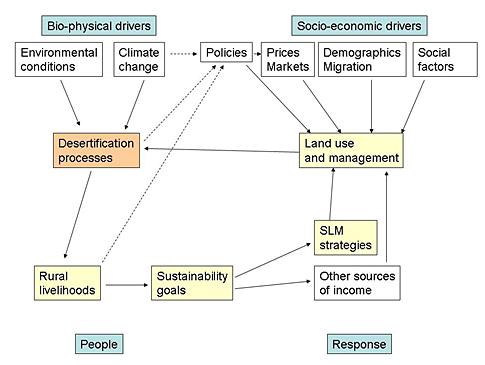 Conceptual framework for DESIRE Conceptual framework for DESIRE
|
The main physical driving forces and processes that cause desertification can be linked in a cause-effect framework.
|
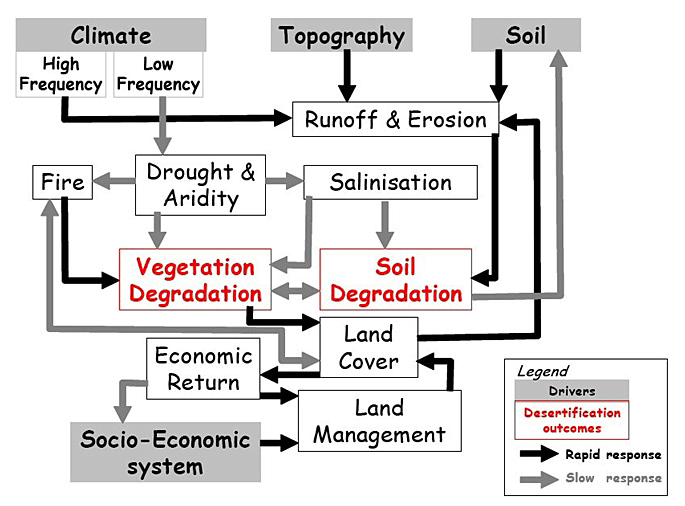 A basic conceptual view of the relationships between the primary drivers of change, climate, soil, geomorphology and socio-economic drivers, and the resulting changes in processes and the degradation effects on vegetation (including agricultural land use) and soil. Source: (DESIRE 2007) A basic conceptual view of the relationships between the primary drivers of change, climate, soil, geomorphology and socio-economic drivers, and the resulting changes in processes and the degradation effects on vegetation (including agricultural land use) and soil. Source: (DESIRE 2007)
|
For example: increased runoff and soil erosion also cause off-site effects such as flooding and siltation of surface waters. There can be feedbacks from the vegetation and soil degradation processes to all primary factors, so that the desertification processes may enter into a downward spiral that leads to irreversible degradation of the whole system. Climate and climate cycles or changes are often the main driving forces of desertification. In many parts of the world prolonged droughts are followed by wetter periods. Dryland ecology can respond quickly to temporal and spatial variability in available moisture, and plants and animals recover rapidly, but, in the longer term, degradation reinforces the tendency to drought.
|
The DPSIR framework (Driving force, Pressure, State, Impact, Response) provides a structure for decision makers to assess the impact of past measures on the status of the environment, or to formulate effective measures for the future.
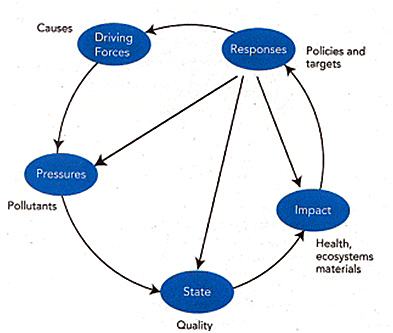
Example of the DPSIR framework (Cefas, 2008) |
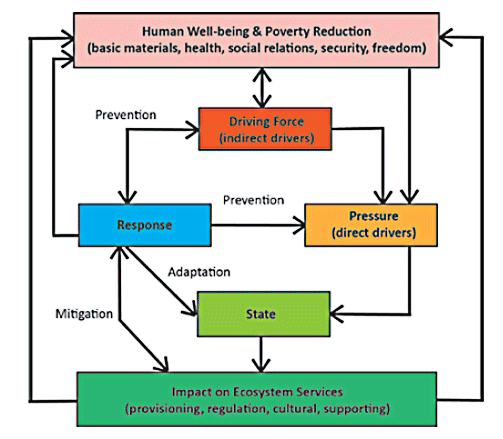
Hybrid DPSIR/Sustainable Land Management framework, from UNU-INWEH, 2011(UNU-INWEH, 2011 Guidelines for the Preparation and Reporting on Globally-relevant SLM Impact Indicators for Project-level Monitoring. United Nations University, Hamilton, Canada.)
|
Policies can be important drivers but also influence the impact of other drivers. In the EU context the Common Agriculture Policy reform and in particular the Water Framework Directive and the upcoming Soil Framework Directives will have a major influence on the ways to achieve sustainable agriculture in Europe.
Many of the DESIRE study site teams report on national laws and regulations as a response of the government to the management of natural resources. These policies can restrict or stimulate specific practices such as forest management, land and water use, conservation or rehabilitation. Desertification is a multidisciplinary and multi-thematic issue and is therefore related to various sectors and levels in policy and government, often with different objectives. Thousands of multilateral and bilateral conventions and agreements relevant to drylands have been developed (e.g. UNCCD, Kyoto Protocol at global level).
More details ... desertification drivers, pressures, impacts, responses and policies in the study sites
|
|
»Guadalentín, Spain
»Mação, Portugal
»Góis, Portugal
»Rendina, Italy
»Crete, Greece
»Nestos River Delta, Greece
»Karapinar, Turkey
»Eskisehir, Turkey
»Sehoul, Morocco
|
»Zeuss Koutine, Tunisia
»Dzhanibek, Russia
»Novy, Russia
»Yan River Delta, China
»Boteti, Botswana
»Cointzio, Mexico
»Secano Interior, Chile
»Ribeira Seca, Cape Verde |
|
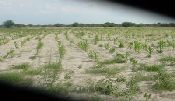


 Conceptual framework for DESIRE
Conceptual framework for DESIRE A basic conceptual view of the relationships between the primary drivers of change, climate, soil, geomorphology and socio-economic drivers, and the resulting changes in processes and the degradation effects on vegetation (including agricultural land use) and soil. Source: (DESIRE 2007)
A basic conceptual view of the relationships between the primary drivers of change, climate, soil, geomorphology and socio-economic drivers, and the resulting changes in processes and the degradation effects on vegetation (including agricultural land use) and soil. Source: (DESIRE 2007)
